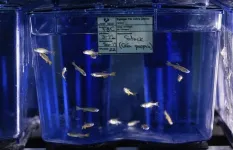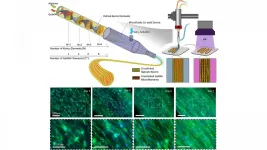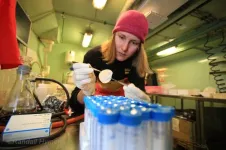(Press-News.org) Chimpanzees and bonobos diverged comparatively recently in great ape evolutionary history. They split into different species about 1.7 million years ago. Some of the distinctions between chimpanzee (Pan troglodytes) and bonobo (Pan paniscus) lineages have been made clearer by a recent achievement in hominid genomics.
A new bonobo genome assembly has been constructed with a multiplatform approach and without relying on reference genomes. According to the researchers on this project, more than 98% of the genes are now completely annotated and 99% of the gaps are closed.
The high quality of this assembly is allowing scientists to more accurately compare the bonobo genome to that of other great apes - the gorilla, orangutan, chimpanzee - as well as to the modern human. All these species, as well as extinct, ancient, human-like beings, are referred to as hominids.
Because chimpanzee and bonobo are also the closest living species to modern humans, comparing higher-quality genomes could help uncover genetic changes that set the human species apart.
In a May 5 Nature paper, researchers explain how they developed and analyzed the new bonobo assembly, and what juxtaposing it to other great ape genomes is revealing.
The multi-institutional project was led by Yafei Mao, of the Department of Genome Sciences at the University of Washington School of Medicine in Seattle, and Claudia R. Catacchio, of the Department of Biology at the University of Bari, Italy. The senior scientists were END
New bonobo genome fine tunes great ape evolution studies
A newly generated bonobo genome assembly is helping pinpoint specific variants that distinguish chimpanzee and bonobo lineages
2021-05-05
ELSE PRESS RELEASES FROM THIS DATE:
Like a Trojan horse, graphene oxide can act as a carrier of organic pollutants to fish
2021-05-05
Graphene is a two-dimensional nanomaterial composed of carbon and formed by a single layer of densely packed carbon atoms. The high mechanical strength and significant electrical and thermal properties of graphene mean that it is highly suited to many new applications in the fields of electronics, biological, chemical and magnetic sensors, photodetectors and energy storage and generation. Due to its potential applications, graphene production is expected to increase significantly in the coming years, but given its low market uptake and the limitations in analysing its effects, little information on the concentrations of graphene nanomaterials in ecosystems ...
Many patients with cancer are experiencing loneliness and related symptoms during the COVID-19 pandemic
2021-05-05
Loneliness and social isolation, which can have negative effects on health and longevity, are being exacerbated by the COVID-19 pandemic. More than half of surveyed adults with cancer have been experiencing loneliness in recent months, according to a study published early online in CANCER, a peer-reviewed journal of the American Cancer Society.
Studies conducted before the pandemic reported that 32 percent to 47 percent of patients with cancer are lonely. In this latest survey, which was administered in late May 2020, 53 percent of 606 patients with a cancer diagnosis were categorized as experiencing loneliness. Patients in the lonely group reported higher levels of social isolation, as well as more severe symptoms of anxiety, depression, ...
3D bioprinting technique controls cell orientation
2021-05-05
WASHINGTON, May 5, 2021 - 3D bioprinting can create engineered scaffolds that mimic natural tissue. Controlling the cellular organization within those engineered scaffolds for regenerative applications is a complex and challenging process.
Cell tissues tend to be highly ordered in terms of spatial distribution and alignment, so bioengineered cellular scaffolds for tissue engineering applications must closely resemble this orientation to be able to perform like natural tissue.
In Applied Physics Reviews, from AIP Publishing, an international research team describes its approach for directing cell orientation within ...
Meet the freaky fanged frog from the Philippines
2021-05-05
LAWRENCE -- Researchers at the University of Kansas have described a new species of fanged frog discovered in the Philippines that's nearly indistinguishable from a species on a neighboring island except for its unique mating call and key differences in its genome.
The KU-led team has just published its findings in the peer-reviewed journal Ichthyology & Herpetology.
"This is what we call a cryptic species because it was hiding in plain sight in front of biologists, for many, many years," said lead author Mark Herr, a doctoral student at the KU Biodiversity Institute and Natural History Museum ...
Methane nibbling bacteria are more active during summer
2021-05-05
"The findings of our study tell us where and when greenhouse gas is being most absorbed in Arctic waters." Says Friederike Gründger, who conducted the study as part of her post-doctoral research at CAGE.
The study, which was conducted on the shallow shelf west of Svalbard, took a closer look at communities of bacteria that use methane as an energy source and carbon substrate for growth. The results from the study show that these methane-oxidizing bacteria are highly affected by the specific underwater landscape and seasonal conditions in the study area.
"Several large depressions, up to 40m deep, are observed along the shallow shelf off Western Svalbard, ...
What is driving reductions in residential greenhouse gas emissions in the US?
2021-05-05
In 2005, greenhouse gas (GHG) emissions from residential energy use hit an all-time high in the United States. Each year since, emissions have dropped at an average annual rate of 2 percent.
In a study published in Environmental Research Letters, "Drivers of change in US residential energy consumption and greenhouse gas emissions, 1990-2015," a team of researchers from the Yale School of the Environment (YSE) outlined several factors that have contributed to this decrease, highlighting efficiencies in new home construction, energy consumption and household appliances, ...
Temple scientists: Drug derived from cannabis shows promising pain-halting effects in mice
2021-05-05
(Philadelphia, PA) - For patients with chronic pain, ineffective treatments, lowered work productivity, and other factors often coalesce, fueling feelings of hopelessness and anxiety and setting the stage for even bigger problems, including substance use disorders. In 2017 alone, some 18 million Americans misused prescription pain relievers over the course of the previous year. In many of these instances, patients suffering from chronic pain became addicted to prescription opioids.
In addition to being highly addictive, many studies suggest that prescription opioids do not effectively control pain over the long term, and hence researchers ...
Personalized sweat sensor reliably monitors blood glucose without finger pricks
2021-05-05
Many people with diabetes endure multiple, painful finger pricks each day to measure their blood glucose. Now, researchers reporting in ACS Sensors have developed a device that can measure glucose in sweat with the touch of a fingertip, and then a personalized algorithm provides an accurate estimate of blood glucose levels.
According to the American Diabetes Association, more than 34 million children and adults in the U.S. have diabetes. Although self-monitoring of blood glucose is a critical part of diabetes management, the pain and inconvenience caused ...
Targeted methods to control SARS-CoV-2 spread
2021-05-05
At the beginning of the COVID-19 pandemic, intense social distancing and lockdown measures were the primary weapon in the fight against the spread of SARS-CoV-2, but they came with a monumental societal burden. New research from the Center for the Ecology of Infectious Diseases and the College of Public Health at the University of Georgia explores if there could have been a better way.
Published in the journal Proceedings of the Royal Society B, the research analyzes more palatable alternatives to the kind of social distancing mandates that threw a wrench at how businesses, schools ...
Journal publishes research review by TTUHSC pharmacy investigator
2021-05-05
A study published in July 2020 hypothesized a link between the presence of bradykinin, a well-known peptide, and severe cases of COVID-19. Vardan Karamyan, Ph.D., an associate professor and vice chair for the Texas Tech University Health Sciences Center (TTUHSC) Jerry H. Hodge School of Pharmacy Department of Pharmaceutical Sciences, had not previously conducted or evaluated any research related to COVID-19. However, he found the article intriguing because it discussed bradykinin, one of three specific peptides with which his lab has much well-published experience.
The paper received a lot of attention in both the media and scientific literature, but as Karamyan read through it, he felt it failed to address an equally important part of a bigger picture: the likely ...
LAST 30 PRESS RELEASES:
Making lighter work of calculating fluid and heat flow
Normalizing blood sugar can halve heart attack risk
Lowering blood sugar cuts heart attack risk in people with prediabetes
Study links genetic variants to risk of blinding eye disease in premature infants
Non-opioid ‘pain sponge’ therapy halts cartilage degeneration and relieves chronic pain
AI can pick up cultural values by mimicking how kids learn
China’s ecological redlines offer fast track to 30 x 30 global conservation goal
Invisible indoor threats: emerging household contaminants and their growing risks to human health
Adding antibody treatment to chemo boosts outcomes for children with rare cancer
Germline pathogenic variants among women without a history of breast cancer
Tanning beds triple melanoma risk, potentially causing broad DNA damage
Unique bond identified as key to viral infection speed
Indoor tanning makes youthful skin much older on a genetic level
Mouse model sheds new light on the causes and potential solutions to human GI problems linked to muscular dystrophy
The Journal of Nuclear Medicine ahead-of-print tip sheet: December 12, 2025
Smarter tools for peering into the microscopic world
Applications open for funding to conduct research in the Kinsey Institute archives
Global measure underestimates the severity of food insecurity
Child survivors of critical illness are missing out on timely follow up care
Risk-based vs annual breast cancer screening / the WISDOM randomized clinical trial
University of Toronto launches Electric Vehicle Innovation Ontario to accelerate advanced EV technologies and build Canada’s innovation advantage
Early relapse predicts poor outcomes in aggressive blood cancer
American College of Lifestyle Medicine applauds two CMS models aligned with lifestyle medicine practice and reimbursement
Clinical trial finds cannabis use not a barrier to quitting nicotine vaping
Supplemental nutrition assistance program policies and food insecurity
Switching immune cells to “night mode” could limit damage after a heart attack, study suggests
URI-based Global RIghts Project report spotlights continued troubling trends in worldwide inhumane treatment
Neutrophils are less aggressive at night, explaining why nighttime heart attacks cause less damage than daytime events
Menopausal hormone therapy may not pose breast cancer risk for women with BRCA mutations
Mobile health tool may improve quality of life for adolescent and young adult breast cancer survivors
[Press-News.org] New bonobo genome fine tunes great ape evolution studiesA newly generated bonobo genome assembly is helping pinpoint specific variants that distinguish chimpanzee and bonobo lineages







